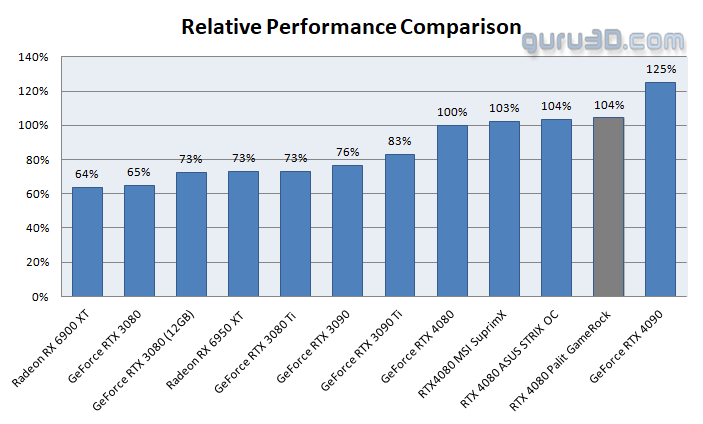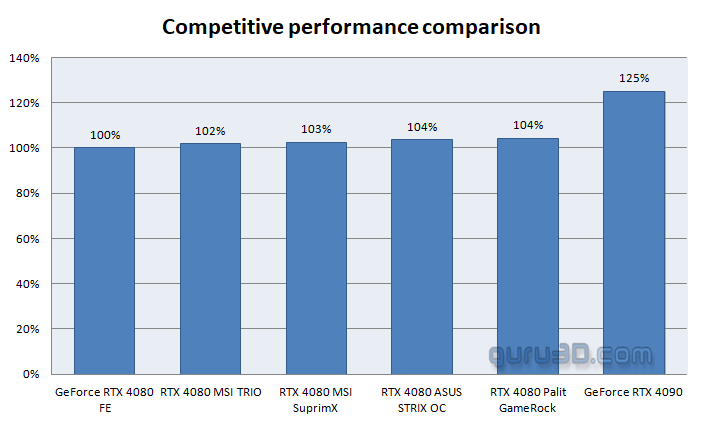Final words and conclusion
Final words
Palit has a very fast and solid offering there with the GameRock OC. IT might look like a lot of bling. but that thing is great looking. Cooling perf is excellent, and acoustics as well. Pricing-wise, expect something $1349. NVIDIA is betting big on DLSS this time around, with vastly improved Tensor cores that aid the new DLSS 3.0, which is currently offering a 2x performance increase. With correct implementation of future games, NVIDIA claims a 3x or 4x performance boost, which is stunning numbers. There, however, is a discussion as to what frame injections really bring to the table other than higher framerates. In the end though, the eye candy on your monitor is what counts, and we cannot complain here. NVIDIA high-end class graphics card face and contend with two obstacles, the first of which is pricing. Starting at $1199 but most likely ending at a 1400 EUR level, these cards have entered a price range that is no longer attainable to most people. PC gaming has become increasingly expensive, driving end users to other solutions. Admittedly also, the new power connector raises concerns. It's not that it's not a safe connector; it's just that bending them too close to the connector combined with sometimes poor quality can lead to hazardous situations. Suppose you need to bend that cable, do it 3-4cm above the connector level. All and rally, ALL cards we have tested to date we have checked with FLIR imaging, and for us, none ever and whatsoever has shown an issue. Back to the GeForce RTX 4080, though; it's a performance extravaganza, but let's extrapolate a bit further.
Performance
You've seen the numbers, and we've already let the cat out of the bag. It all comes down to gaming performance and, of course, rendering quality. Yes the RTX 4080 provides more value for the money than seen from the 4090, as we're getting close to raw performance levels that easily enable gaming at 4K resolution. Most enthusiast gamers play at UWHD, QHD, or UHD monitor resolutions. This card is designed for precisely that kind of gamer.
The old rasterizer engine breaks right through the previous limit of extreme performance. Because of the 9K Shading processors, all of this is possible. The RTX 40 series now has a new generation of Ray tracing and Tensor cores that are more powerful. So, do not let the specific RT and Tensor core counts fool you; it's all about how much performance one unit offers. Since they are close to the shader engine, they have become more efficient, which shows. Tensor cores are harder to measure, but from what we have seen, everything seems to be in good shape, as DLSS3 shows exciting values. Overall, the GeForce RTX 4080 makes sense at resolutions as low as 2K 2560x1440, up to 4K (3840x2160).
Cooling & noise levels
The design for cooling is great. Under full load, this product, which is made for enthusiasts and uses a lot of power, uses about 325 Watts. This Wattage is directly related to how much heat the GPU gives inside a closed chassis. We got 32~33 dBA, an incredibly silent sound level. Expect the card to get close to 60-65°C when it is under a lot of stress. This number can increase depending on how well air moves through your case. FLIR imaging does not show anything scary.
Energy
We touched the topic a bit; the power draw under intensive gaming for GeForce RTX 4080 is high, especially when energy prices are soaring; this product isn't a good example. We measured it to be close to the 325 Watt range. This is the tradeoff for a bit more bite in performance for this graphics card model in particular. Gaming wise that number will fluctuate a bit; however, 275+ Watt it'll do in no time. We expect the board partner cards to show higher numbers as they get more TGP allowance.
Coil whine
Much like the 3080, the GeForce RTX 4080 does exhibit coil squeal. Is it annoying? It's at a level you can hear it. In a closed chassis, that noise would fade away in the background. However, you can hear minor coil whine/squeal with an open chassis. Graphics cards all make this in some sort or form, especially at high framerates this can be perceived. It's as good as it can get, and we have not been bothered by it.
Pricing
The reference/founder edition of NVIDIA's GeForce RTX 4080 costs USD 1199, which is too much for most of us to pay for something that can be used to play PC games. This product is so unique that it has its market. NVIDIA might have been able to charge even more for the product and still sell many of them. AIB will cost even more. Now, I can say all kinds of rude things about prices, but these products will still sell no matter what I say. Expect a 150 USD price premium for this GameRock OC model.
Tweaking
The card tweaks well. The GPU constantly hits the power limiter Watts with the +17% power limiter, so that's your first and quickest option to tweak. You get extra perf on the card's default power budget. The clock frequency can take a good +100~125 MHz extra. Apply it, and you'll see the GPU boost clock hovering in the 3000~3050 MHz domain (frequencies vary per game title as they are dynamic). The memory could be tweaked to 24+ Gbps, so all these are terrific values that brought ~7% additional performance on challenging GPU situations, measured from founder edition reference performance.
Conclusion
Aesthetically and functionally (in terms of how well it performs in games), it is a fantastic item, but the looks are subject to personal preference. What I care about most is how well something performs, how cool it stays, and how much it costs. On these fronts, Palit certainly delivers. As video outputs, you can choose between three DisplayPort and one HDMI. From a hardware and performance point of view, the GeForce RTX 4080 is downright fantastic. However, we live in challenging times, with a war close to the EU border, soaring energy prices, and life has gotten much harder and more expensive. That does make products like those shown today harder to defend; then again, we can't blame NVIDIA for the state of the world in 2022. We hope to see affordable low-energy products sooner rather than later from NVIDIA. As a piece of hardware all by itself, we can only applaud the 4080. TheADA GPU architecture can perform skillfully and excellently. A good chunk of extra shader cores brings in nearly 1.5x raw shader performance and even better Raytracing and Tensor core performance. Underlying technologies like Shader Execution Reordering (SER) and DLSS 3.0 make the new product and Series 4000 shine. The GeForce RTX 4080 offers staggering numbers. Starting at $1199, however, it's very expensive. If you have the wallet leniency and play games in Ultra HD or, at the very least, start at a monitor resolution of 2560x1440, we can't argue that it'll be a great addition towards any enthusiast-class gaming rig. Take Microsoft Flight Simulator 2020 combined with DLSS 3.0; you can fly at 100+ FPS in the highest resolutions. Cyberpunk at UHD with raytracing and DLSS3 quickly passes 100 FPS. This purebred Ultra HD card shines in that area, whether shading (regularly rendered games) or hybrid ray-tracing + DLSS3 is used. Compared to the mighty 4090, this still is a more economical product series offering massive performance. In closing, the RTX 4080 impresses and will keep you happy for years, but at a high cost and energy consumption. Never has built a new game PC been this expensive, but never have things been this fast. The sheer performance and novelty of these x-factor items astound us as hardware enthusiasts. Palit offers a rockin' product, alright. The default extra performance is only 3~4%. Still, if you are really into silent operation and are into the looks, it is a card we can recommend over the founder edition at a price premium of just $150
Sign up to receive a notification when we publish a new article.
Or go back to Guru3D's front page
- Hilbert, LOAD"*",8,1.




